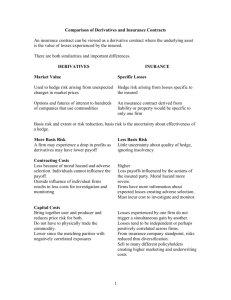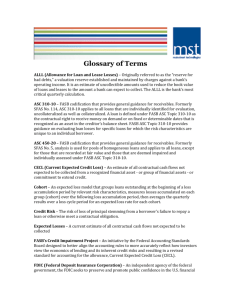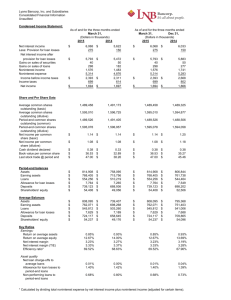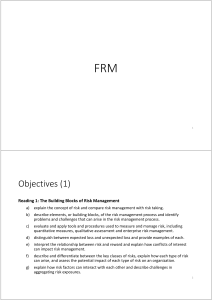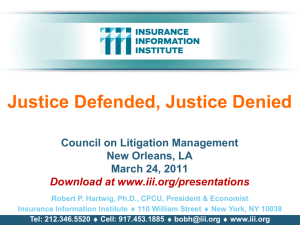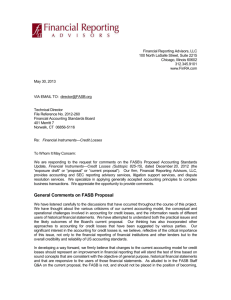Why New Approaches to Credit Risk Measurement and Management?
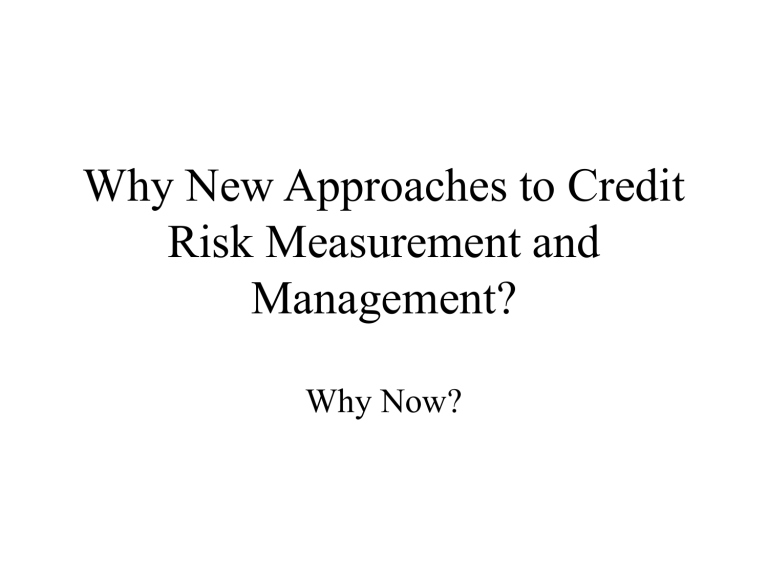
Why New Approaches to Credit
Risk Measurement and
Management?
Why Now?
Structural Increase in Bankruptcy
• Increase in probability of default
– High yield default rates: 5.1% (2000), 4.3% (1999,
1.9% (1998). Source: Fitch 3/19/01
– Historical Default Rates: 6.92% (3Q2001), 5.065%
(2000), 4.147% (1999), 1998 (1.603%), 1997 (1.252%),
10.273% (1991), 10.14% (1990). Source: Altman
• Increase in Loss Given Default (LGD)
– First half of 2001 defaulted telecom junk bonds recovered average 12 cents per $1 ($0.25 in 1999-2000)
• Only 9 AAA Firms in US: Merck, Bristol-Myers,
Squibb, GE, Exxon Mobil, Berkshire Hathaway,
AIG, J&J, Pfizer, UPS. Late 70s: 58 firms. Early
90s: 22 firms.
2
Disintermediation
• Direct Access to Credit Markets
– 20,000 US companies have access to US commercial paper market.
– Junk Bonds, Private Placements.
• “Winner’s Curse” – Banks make loans to borrowers without access to credit markets.
3
More Competitive Margins
• Worsening of the risk-return tradeoff
– Interest Margins (Spreads) have declined
• Ex: Secondary Loan Market: Largest mutual funds investing in bank loans (Eaton Vance Prime Rate
Reserves, Van Kampen Prime Rate Income, Franklin
Floating Rate, MSDW Prime Income Trust): 5-year average returns 5.45% and 6/30/00-6/30/01 returns of only 2.67%
– Average Quality of Loans have deteriorated
• The loan mutual funds have written down loan value
4
The Growth of Off-Balance
Sheet Derivatives
• Total on-balance sheet assets for all US banks = $5 trillion (Dec. 2000) and for all
Euro banks = $13 trillion.
• Value of non-government debt & bond markets worldwide = $12 trillion.
• Global Derivatives Markets > $84 trillion.
• All derivatives have credit exposure.
• Credit Derivatives.
5
Declining and Volatile Values of
Collateral
• Worldwide deflation in real asset prices.
– Ex: Japan and Switzerland
– Lending based on intangibles – ex. Enron.
6
Technology
• Computer Information Technology
– Models use Monte Carlo Simulations that are computationally intensive
• Databases
– Commercial Databases such as Loan Pricing
Corporation
– ISDA/IIF Survey: internal databases exist to measure credit risk on commercial, retail, mortgage loans. Not emerging market debt.
7
BIS Risk-Based Capital
Requirements
• BIS I: Introduced risk-based capital using 8%
“one size fits all” capital charge.
• Market Risk Amendment: Allowed internal models to measure VAR for tradable instruments
& portfolio correlations – the “1 bad day in 100” standard.
• Proposed New Capital Accord BIS II – Links capital charges to external credit ratings or internal model of credit risk. To be implemented in 2005.
8
Appendix 1.1
A Brief Overview of Key VAR Concepts
• Banks hold capital as a cushion against losses. What is the acceptable level of risk?
• Losses = change in the asset’s value over a fixed credit horizon period (1 year) due to credit events.
• Figure 1.1- normal loss distribution. Figure 1.2 – skewed loss distribution. Mean of distribution = expected losses
(reserves).
• Unexpected Losses (UL) = %tile VAR. Losses exceed UL with probability = %.
• Definition of credit event:
– Default Mode: only default
– Mark-to-market: all credit upgrades, downgrades & default.
9
Figure 1.1 Normal loss distribution.
Probability
%
FIGURE 1.1
99.5th Percentile
(Maximum) Value
Conf idence
Interval
0.5%
EL
Expected
Losses
(EL)
EL
Unexpected
Losses, VAR
(UL)
Loss Distribution
Figure 1.2 Skew ed loss distribution.
Probability
%
Expected
Losses
(EL)
Unexpected
Losses, VAR
(UL)
Loss Distribution
11


